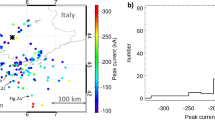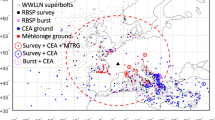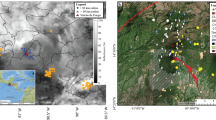Abstract
LATITUDINAL variations in lightning-flash characteristics have been hypothesized1,2, but have not been found to exist3,4. This may be because lightning characteristics are constant over the Earth, or because the observations have been made over too small an area of the globe. To investigate the question of latitudinal variation, I have used a network of thirty-six gated wideband magnetic direction finders covering the eastern United States to measure the characteristics of cloud-to-ground lightning flashes. These characteristics include the flash location, the flash polarity, the number of strokes in the flash and the peak magnetic radiation field in the first return stroke of the flash. From the peak radiation field, I estimate the peak current5. More than five million lightning ground flashes were recorded by the network in 1988. An examination of the mean peak current in the first return stroke shows that the peak current varies by almost a factor of two, from 25k A in New England to 40–45 kA in northern Florida. Apparently, this is the first report of an important lightning parameter, the return stroke current, varying over a large area of the globe. It seems that the generation of lightning strokes and their characteristics may be a sensitive function of latitude and hence of temperature. The results presented here indicate that even higher peak currents will be observed if this research is extended into the equatorial regions.
This is a preview of subscription content, access via your institution
Access options
Subscribe to this journal
Receive 51 print issues and online access
$199.00 per year
only $3.90 per issue
Buy this article
- Purchase on SpringerLink
- Instant access to full article PDF
Prices may be subject to local taxes which are calculated during checkout
Similar content being viewed by others
References
Pierce, E. T. J. appl. Met. 9, 194–195 (1970).
Takeuti T., Nakano, M. & Nagatani, M. J. met. Soc. Jap. 53, 360–361 (1975).
Harris, D. J. & Salman, Y. E. J. atmos. terr. Phys. 34, 775–786 (1972).
Thomson, E. M. J. geophys. Res. 85, 1050–1056 (1980).
Uman, M. A., McLain, D. K. & Krider, E. P. Am. J. Phys. 43, 33–38 (1975).
Orville, R. E., Henderson, R. W. & Bosart, L. F. Bull. Am. met. Soc. 64, 1029–1037 (1983).
Orville, R. E. Jr J. geophys. Res. 92, 10877–10886 (1987).
Fieux, R. P., Gary, C. & Hubert, P. Nature 257, 212–214 (1975).
Idone, V. P., Orville, R. E., Hubert, P., Barret, L. & Eybert-Berard, A. J. geophys. Res. 89, 1385–1394 (1984).
Berger, K. Bull. schweiz. electrotech. Ver. 63, 1403–1422 (1972).
Williams, E. R. J. geophys. Res. 90, 6013–6025 (1985).
National Climatic Center Selected Meridional Cross Sections of Heights, Temperatures and Dew Points of the Northern Hemisphere NAVAIR-50-1C-59 (National Climatic Center, Ashville, North Carolina, 1970).
Author information
Authors and Affiliations
Rights and permissions
About this article
Cite this article
Orville, R. Peak-current variations of lightning return strokes as a function of latitude. Nature 343, 149–151 (1990). https://doi.org/10.1038/343149a0
Received:
Accepted:
Issue date:
DOI: https://doi.org/10.1038/343149a0
This article is cited by
-
Long-Term Spatial–Temporal Characterization of Cloud-to-Ground Lightning in the Metropolitan Region of Rio de Janeiro
Pure and Applied Geophysics (2019)



